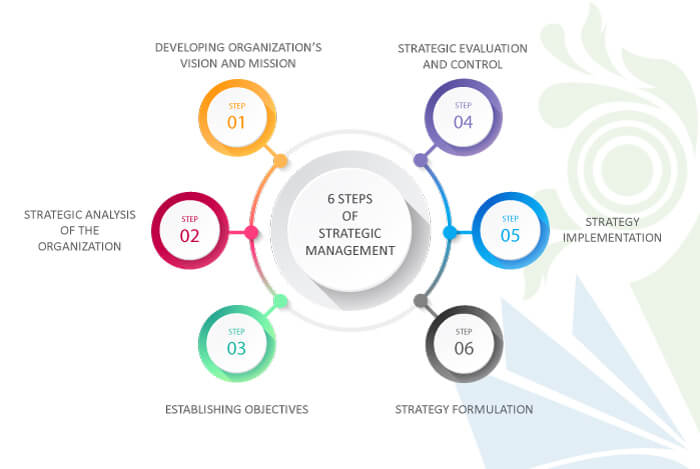Strategic Management Process 6 Steps
Strategic management is construed in the context of a process. Strategic management process 6 steps is an identifiable flow of information through interrelated stages of analysis directed toward achieving an aim. In the strategic management process 6 steps, the strategists primarily determine objectives and make strategic directions and actions. It is involved with the development of an effective strategy to help achieve organizational objectives. Our operational definition of strategic management process 6 steps are:
Strategic Management Process 6 Steps:
There are included the Strategic management process 6 steps. Strategic management process 6 steps are:-
- Developing the Organization’s Vision and Mission
- Strategic Analysis of the Organization
- Establishing Objectives
- Strategy Formulation
- Strategy Implementation
- Strategic Evaluation and Control

This definition encompasses six inter-related issues of strategic management process 6 steps. Such as:-
- First, the strategy-makers develop a vision for the organization and then formulate a mission in the light of the vision. While a vision states ‘where we are going,’ a mission describes its present business and its purpose for existence.
- Secondly, the strategy-makers conduct a thorough analysis of the organization’s internal and external environments to gather enough information for setting objectives.
- They set objectives in the third phase. These objectives subsequently use for measuring the organization’s performance and progress.
- Fourthly, they embark upon the most important task in strategic management – formulation of a strategy to achieve the objectives in the third phase. A strategy comprises the organization’s managers’ actions and approaches to effectively and efficiently achieve the vision, mission, and objectives.
- In the fifth phase of the strategic management process 6 steps, the managers accomplish all the necessary organizational tasks for the sound implementation of the chosen strategy.
- Finally, managers monitor developments, evaluate the performance of all those involved with implementing a strategy and make corrective adjustments in the organization’s objectives, strategy, or implementation plan based on actual situations, including new developments in the environment well new ideas and opportunities. That means strategic evaluation and control attempts to establish standards of performance, monitors progress during the implantation strategy, and (if anything goes wrong) intimate corrective adjustments.
Developing the Organization’s Vision and Mission:
In the strategic management process 6 steps, developing the organization’s vision and mission is the first step. In this step will be discussed the vision and mission separately.
Strategic Analysis of the Organization:
The analysis is a main phase of the strategic management process 6 steps because the information added in this phase will form the next two phases. In this phase, fold as much material and information relevant to completing your vision. The emphasis of the examination should be on thoughtful business desires as a defensible unit, its strategic track, and classify creativities that will benefit your business raise. Scrutinize any outside or interior topics that can touch your goal line and purposes. Make sure to categorize both the strong point and dimness of your organization over and above any intimidations and changes that may arise along the trail.
Establishing Objectives:
It is the third step of the strategic management process 6 steps. Establishing an objective is a direction-setting task. A mission statement provides an organization’s overall goal but does not enable managers to go for action. Managers, consequently, need to change the mission to precise performance objects. Establishing objectives adapts vision and mission to explicit performance consequences. Objectives must set for monetary performance and plan performance for accomplishment. Top managers set broader objectives with longer time horizons than do successively lower levels of managers. Lower-level managers set objectives based on middle-level objectives. In effect, lower-level objectives provide the means for achieving middle-level objectives and, in turn, middle-level objectives provide the means for achieving top-level objectives.
Strategy Formulation:
After completing the strategic analysis of a company, managers are now in possession of a strong pool of information regarding the industry competition, external opportunities and threats, and weaknesses. They would logically proceed with term objectives for the would formulate appropriate endeavor to gain a competitive market.
Formulation of strategy (fourth step of the strategic management process 6 steps) is to ease the strategy; managers need to have an in-depth look at several issues. They expect to identify the generic. And other competitive strategies as applicable to single-business companies and match the strategies to industry and company situations.
Under this step of the strategic management process 6 steps; will discuss the following these topics. Such as:-
- Formulation of competitive strategies that a single business company can employ for achieving competitive advantages
- Matching strategy with the industry and company situations and
- Formulation of corporate strategy.
Link: Different Types of Public Enterprises and Principles of NPM
Strategy Implementation:
The fifth step is the strategy implementation of the strategic management process 6 steps. Effective strategy implementation is precarious to the attainment of the business endeavor. This is the stroke phase of the Strategic management process 6 steps. If the general strategy does not effort with the business’ existing construction, a fresh construction should be fitted at the opening of this point. Every person within the business must make rich of their farm duties and responsibilities, and how that hysterics in with the general objective. Furthermore, any capitals or backing for the endeavor must protect by this argument. Once the aid is in place, and the staffs prepare, perform the design.
Read More: Risk Management Process
Strategic Evaluation and Control:
Strategic evaluation and control is the final one of the strategic management process 6 steps. The internal and external environments of an organization are constantly changing. Such changes can make the organization’s strategies obsolete. Thus, it is essential to periodically review, evaluate, and control the strategies that the organization has been implementing. Timely evaluation and control would help managers take corrective measures to keep everything on track.
These are the strategic management process 6 steps in the strategic management concept. You can use or follow the attached links for getting more knowledge about the Strategic management process 6 steps of strategic management overview with its important types.




Nice article for strategic manage steps.
Thanks for Tarek Mahmud your comments and keep touch our this official administrative higher studies related website.
This is a site that inspires me and informs me correctly, which is why I want to tell you how I managed to overcome the loss of my work from home,
From your description, I’m so clear about the process of strategic management.